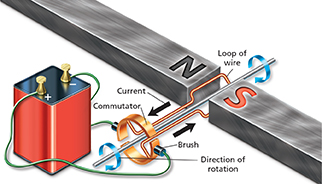Electric Motors
An electric motor is a device that uses an electromagnet to turn an axle. Figure 11 shows how an electric motor works. In this figure, the wire is connected to a battery. An actual motor has many loops of wire around a central iron core to make the motor stronger. In the motor of an electric appliance, the wire would be connected to an electrical circuit in a building.
Figure 11A battery supplies current to a loop of wire through the commutator. As the commutator turns, the direction of current switches back and forth. As a result, the coil's magnetic field keeps switching direction, and this turns the coil about an axle. Predicting What would happen if you reversed the positive and negative connections on the battery?
 d
dWhat makes a motor turn? When current flows through a loop of wire, one side of the loop is pushed by the field of the permanent magnet. The other side of the loop is pulled. These forces rotate the loop. If there were no commutator ring, the coil would come to rest. But as the loop turns, each C-shaped half of the commutator connects with a different brush, reversing the current. The forces now change direction, so the coil continues to rotate. As long as current flows, rotation continues.
Loudspeakers
A loudspeaker contains a solenoid placed around one pole of a permanent magnet. The current in the wires entering the loudspeaker changes direction and increases or decreases to reproduce music, voices, or other sounds. The changing current produces a changing magnetic field in the solenoid coil. The magnetic force exerted by the permanent magnet moves the coil back and forth. As the coil moves, it causes a thin membrane to vibrate, producing sound waves that match the original sound.
Section 21.2 Assessment
Reviewing Concepts
 Besides a magnet, what can create a magnetic field?
Besides a magnet, what can create a magnetic field? How is the magnetic field of an electromagnet controlled?
How is the magnetic field of an electromagnet controlled? How are solenoids and electromagnets used in galvanometers, electric motors, and loudspeakers?
How are solenoids and electromagnets used in galvanometers, electric motors, and loudspeakers?How does a ferromagnetic rod inside a solenoid affect the strength of an electromagnet?
Critical Thinking
Comparing and Contrasting What is the effect of a magnetic field on a stationary electric charge? On a moving electric charge?
Applying Concepts Why is it a good idea to have the coil of a solenoid wound closely with many turns of wire?
Inferring What is the purpose of the commutator in an electric motor?
Relating Cause and Effect What causes the membrane in a loudspeaker to vibrate?
Connecting Concepts
Insulators
In Section 20.2 you learned that electric charge doesn't flow easily through electrical insulators. Use this to explain why a solenoid has insulated wires.




